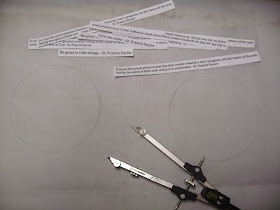I originally shared this post over at Shower of Roses, but thought I would add it here as well for anyone who is looking for All Saints' party game ideas!
The
All Saints Guessing Jars were such a hit at
our annual All Saints Party last year that we will be including them again this year with 12 MORE Saint Themed Guessing Jars!
I always have so much fun looking through the aisles at the grocery store and trying to connect some of the goodies to saints and their symbols!

"Bit-O-Honey" candies for St. Ambrose (the "Honey-Tongued Doctor") and Polish Candy for St. John Paul II are a couple of my favorite additions for this year. Once again I used my
Wide Mouth Mason Jars with
White Storage Lids for each jar.
Here are some pictures of this year's All Saints Guessing Jars all filled and ready for the party:
St. Ambrose :: St. Ambrose is also known as the "Honey Tongued Doctor." Any type of honey candy would work for this saint. I picked up three 4.2 oz bags of Bit-O-Honey at a local store to fill the jar. You can also
purchase 16 oz. over at Amazon.

 St. Bernadette of Lourdes ::
St. Bernadette of Lourdes :: Pretzel Sticks are perfect for St. Bernadette, since she was out collecting firewood when Our Lady of Lourdes appeared to her at the Grotto. Twix candy bars would also work!
St. Gertrude the Great :: Saint Gertrude the Great had a deep empathy for the Church suffering, the Holy Souls in Purgatory. Our Lord shared a special prayer with St. Gertrude the Great and told her that the prayer would release 1,000 Souls from Purgatory each time it is prayed. The
GhostMallows in the jar represent the "Holy Souls." I used one 8 oz bag to fill the jar and had a few left over.

 St. John Paul II ::
St. John Paul II :: I had to find a way to incorporate the newly canonized St. John Paul II! Polish candy works, right? :) Ours came directly from a Polish friend, but it
can also be found on Amazon if you aren't able to find any locally.
St. Kateri Tekakwitha :: This saint, who belonged to a Native American Indian Tribe, is also known as the "Lily of the Mohawks." We have made
Indian Corn Cookies in honor of St. Kateri in the past, but for the jar I just filled it with one 21 oz bag of
Candy Corn. (Though it probably could have used just a little bit more.) Lily candies would also work. If you have a mold you can
make your own!

 St. Marianne Cope ::
St. Marianne Cope :: HI-Chews are actually a Japanese Candy, but since my family was first introduced to them when my sister brought us some from Hawaii (along with the fact that they have "HI" in the name, the abbreviation for Hawaii) I thought we could get away with using them for St. Marianne Cope, who cared for the sick in Hawaii for 35 years. I bought a big bag at Costco when they were on special for less than $5.00 and only used about 2/3's of the bag. You can also
find them on Amazon.
St. Matthew :: My husband thought it might be a little offensive to St. Matthew to fill his jar with "Payday" candy bars, but after I told him that St. Matthew is the patron of accountants he agreed that it was okay. :) I probably should have purchased "fun size" candy bars, but I ended up using about 2/3's of a 20.3 oz bag of the "snack size."


St. Nicholas of Myra :: It's a little difficult to find candy canes quite yet, but JoAnn's just put out their Christmas supplies this week so I picked up a box of miniature candy canes. Be super careful not to drop them when you take them out of the box… They don't just break, they shatter! ;)
St. Patrick of Ireland :: Pious legend credits St. Patrick with banishing snakes from the island of Ireland, chasing them into the sea. Regardless of whether or not this legend is true, St. Patrick is the patron saint against snakes, fear of snakes, and snake bites. Gummy Worms look like snakes.


St. Peter :: Butter Snaps Pretzels make yummy little Fisherman's Nets for St. Peter, the patron saint of Fisherman. Fish also would have worked, but I saved those for the next saint on the list.
St. Raphael :: There are so many saints that are symbolized in some way with a fish. This year I decided to focus on St. Raphael, the healer, who is recorded as having helped Tobias make balms and ointments from fish to cure Tobit's (Tobias's father) blindness.
St. Thomas Aquinas :: Even though St. Thomas Aquinas' classmates called him "The Dumb Ox" he became a great Doctor of the Church and Patron of Academics. I filled a jar with a 12 oz. bag of
Smarties in his honor!
(After I made my jars for this year I clicked back over to Catholic Inspired, since I couldn't remember what she included in her jars last year, and she used Smarties for all the Doctors of the Church and "Dum-Dums" for St. Thomas. They would have worked too.)
To keep each person's guesses secret I also created little
sheets of paper for each contestant to write their name and guess, before folding it in half and dropping it into an empty jar or bag with a matching label.
It's all ready to go and I can check this off the to-do list…
Now to start working on the rest of the party plans!











































































